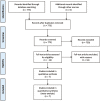Endoscopic third ventriculostomy versus ventriculoperitoneal shunt insertion for the management of pediatric hydrocephalus in African centers - A systematic review and meta-analysis
- PMID: 36324983
- PMCID: PMC9610522
- DOI: 10.25259/SNI_747_2022
Endoscopic third ventriculostomy versus ventriculoperitoneal shunt insertion for the management of pediatric hydrocephalus in African centers - A systematic review and meta-analysis
Abstract
Background: Ventriculoperitoneal shunt (VPS) insertion and endoscopic third ventriculostomy (ETV) are common surgical procedures used to treat pediatric hydrocephalus. There have been numerous studies comparing ETV and VPS, but none from an African perspective. In this study, we sought to compare outcomes from African neurosurgical centers and review the associated complications.
Methods: The Preferred Reporting Items for Systematic Reviews and Meta-Analyses were used in conducting this study. PubMed, Google Scholar, and African Journal Online were searched. Data on treatment successes and failures for ETV and VPS were pooled together and analyzed with a binary meta-analysis. A clinically successful outcome was defined as no significant event or complication occurring after surgery and during follow-up (e.g., infection, failure, CSF leak, malfunction, and mortality). Seven studies fully satisfied the eligibility criteria and were used in this review.
Results: There was no statistically significant difference between the outcomes of ETV and VPS (OR- 0.27; 95% CI -0.39-0.94, P = 0.42). After reviewing the rates of complications of ETV and VPS from the identified studies, four were recurrent. The infection rates of ETV versus VPS were 0.02% versus 0.1%. The mortality rates were 0.01% versus 0.05%. The reoperation rates were 0.05% versus 0.3%, while the rates of ETV failure and shunt malfunction were 0.2% versus 0.2%.
Conclusion: This study concludes that there is no significant difference between the outcomes of ETV and VPS insertion.
Keywords: Endoscopy; Infection; Malfunction; Ventriculostomy.
Copyright: © 2022 Surgical Neurology International.
Conflict of interest statement
There are no conflicts of interest.
Figures
References
-
- Adebayo BO, Kanu OO, Bankole OB, Ojo OA, Adetunmbi B, Morgan E. Early outcome of endoscopic third ventriculostomy with choroid plexus cauterization versus ventriculoperitoneal shunt as primary treatment of hydrocephalus in children with myelomeningocele: A prospective cohort study. Oper Neurosurg (Hagerstown) 2021;21:461–6. - PubMed
-
- Albright AL. Reflections on developing pediatric neurosurgery in Sub-Saharan Africa. J Neurosurg Pediatr. 2016;18:127–38. - PubMed
-
- Appelgren T, Zetterstrand S, Elfversson J, Nilsson D. Long-term outcome after treatment of hydrocephalus in children. Pediatr Neurosurg. 2010;46:221–6. - PubMed
-
- Bryant MJ, McEniery J, Walker DG, Campbell R, Lister B, Sargent P, et al. Preliminary study of shunt related death in paediatric patients. J Clin Neurosci. 2004;11:614–5. - PubMed
-
- Cairo SB, Agyei J, Nyavandu K, Rothstein DH, Kalisya LM. Neurosurgical management of hydrocephalus by a general surgeon in an extremely low resource setting: Initial experience in North Kivu province of eastern democratic republic of Congo. Pediatr Surg Int. 2018;34:467–73. - PubMed
Publication types
LinkOut - more resources
Full Text Sources





